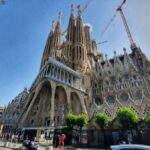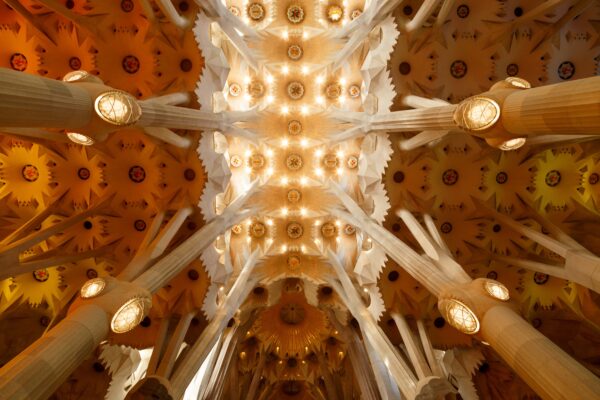
Barcelona's Sagrada Familia stands as a testament to the genius of architect Antoni Gaudí, captivating visitors with its intricate designs and towering spires. However, the true beauty of this iconic basilica lies within, where light and color dance through the stunning stained glass windows, creating an ethereal ambiance that leaves a lasting impression.
In this journey of discovery, we delve into the heart of Gaudí's masterpiece, revealing the architectural innovations and spiritual symbolism that define its interior. Join us as we embark on a fascinating exploration, showcasing the wonders that await inside the Sagrada Familia, truly capturing the essence of Inside the Marvels of Barcelona: Exploring the Interior of the Sagrada Familia.
Inside the Artistic Brilliance of the Sagrada Familia's Interior
Stepping inside the Sagrada Familia is akin to entering a celestial realm where every detail reflects Gaudí's deep reverence for nature and spirituality. The interior's unique columns, reminiscent of trees, branch out to support the vaults, creating a forest-like atmosphere. This innovative use of geometry not only enhances acoustics but also invites visitors to experience a profound sense of tranquility.
The play of light is perhaps one of the most striking features of the interior. As sunlight filters through the exquisitely designed stained glass, it casts vibrant colors across the stone, transforming the space into a living canvas. The use of colors varies throughout the day, offering visitors a distinct experience during different times, which can be best appreciated through a brief overview of the stained glass themes:
- Morning light: Soft pastel hues, evoking calmness.
- Midday sun: Bright, vivid colors that energize the space.
- Evening glow: Warm, golden shades creating an intimate ambiance.
Additionally, the intricate details found in the mosaics and sculptures serve as a narrative of the Christian faith, bridging art and devotion. Each element tells a story, from the nativity scenes to the depictions of saints, all meticulously crafted to inspire awe and reflection. This artistic synthesis is not only a showcase of Gaudí's vision but also a profound invitation for visitors to connect with the spiritual essence of the Sagrada Familia.
Unveiling the Symbolism Behind the Colors in Sagrada Familia
The colors within the Sagrada Familia are not merely decorative; they embody a profound symbolism that reflects Gaudí's vision of spirituality and nature. Each hue is thoughtfully chosen to convey different emotions and themes, enhancing the visitor's experience. For instance, the vibrant reds and oranges symbolize divine love and passion, while the cooler blues and greens evoke calmness and peace.
As sunlight filters through the stained glass, it creates a dynamic spectrum of colors that shift throughout the day. This transformation is not just visually stunning but also serves a deeper purpose. The varying colors resonate with different aspects of the Christian faith, representing concepts such as hope, faith, and redemption. This interplay of light and color invites visitors to contemplate their own spiritual journeys.
To better illustrate the meanings behind specific colors used in the Sagrada Familia, consider the following:
- Red: Represents love and sacrifice.
- Blue: Symbolizes serenity and trust.
- Green: Reflects growth and renewal.
- Yellow: Evokes joy and enlightenment.
Ultimately, the thoughtful use of colors within the Sagrada Familia transforms the interior into a living testament to Gaudí's artistic genius and his ability to weave together art, nature, and spirituality. Each visit offers a new perspective, revealing the sacred story told through the lens of color, light, and architectural brilliance.
A Journey Through the Architectural Marvels of Gaudí's Masterpiece
The interior of the Sagrada Familia is a symphony of architectural innovation and artistry, where every element serves a purpose. Gaudí's visionary approach integrates nature's forms into the design, creating a space that transcends traditional basilica architecture. Visitors are greeted by towering columns that mimic the trunks of trees, symbolizing growth and connection to the natural world. This unique structural choice not only enhances the aesthetic experience but also reinforces the spiritual journey of those who enter.
One of the most remarkable aspects of the Sagrada Familia's interior is its dynamic interaction with light. The play of colors, created by the stained glass windows, transforms the atmosphere throughout the day. This ethereal quality allows the interior to evolve, providing a unique emotional experience during each visit. Key elements of this light and color interaction include:
- Spatial Harmony: The arrangement of light enhances the sense of tranquility and peace.
- Emotional Resonance: Different colors evoke specific feelings and spiritual reflections.
- Architectural Play: The light interacts with various surfaces, highlighting the intricate details of Gaudí's work.
In addition to its aesthetic allure, the Sagrada Familia's interior is rich with spiritual symbolism. Every sculpture and mosaic narrates the story of faith, inviting visitors to engage with the narratives depicted through art. The thoughtful placement of these works allows for a journey through Christian teachings, with careful attention to detail that reflects Gaudí's belief in the divine and the sacred connection between humanity and God.
The fusion of architecture, art, and spirituality in the Sagrada Familia creates an unparalleled experience that encourages contemplation and inspiration. Each visit reveals new layers of meaning, showcasing how Gaudí's legacy continues to resonate with those who seek to explore the depths of this architectural marvel. Whether through the breathtaking columns or the vibrant light, the interior of the Sagrada Familia stands as a testament to the enduring power of creative vision.
Exploring the Spiritual Significance of the Sagrada Familia's Design
Exploring the spiritual significance of the Sagrada Familia's design offers a unique window into Gaudí's vision, where architecture transcends mere functionality to become a medium of divine expression. The basilica is structured to evoke feelings of reverence and peace, inviting visitors to engage in reflection and contemplation. This atmosphere is enhanced by the integration of natural elements, which symbolize the connection between the earth and the celestial, reinforcing the idea of a sacred space.
Throughout the interior, one can observe how Gaudí's use of forms and shapes mimics organic structures, illustrating the divine presence in nature. The columns, resembling tree trunks, serve as a reminder of the interconnectedness of all living beings. These architectural choices not only beautify the space but also underscore significant spiritual themes, inviting visitors to ponder their own relationship with the divine. Key spiritual elements include:
- Nature as a Reflection of the Divine: Gaudí believed that nature was a manifestation of God's creation.
- The Journey of Faith: Each architectural detail guides the visitor through the narrative of Christian beliefs.
- Transcendence through Art: The intricate designs elevate the soul, encouraging moments of introspection.
The interplay of light and color within the Sagrada Familia further enriches its spiritual ambiance. As sunlight penetrates the stained glass, it infuses the space with a myriad of colors, each representing different aspects of faith. This dynamic interaction creates a sense of wonder and awe, allowing visitors to experience a profound connection with both the artwork and their own spirituality. This transformative quality serves as a powerful reminder of the basilica's role as a place of worship and reflection.
Ultimately, the interior of the Sagrada Familia is a harmonious blend of art, nature, and spirituality. Gaudí's masterful design not only captivates the eye but also speaks to the soul, fostering a deeper understanding of faith and devotion. Each visit to this architectural wonder unveils new layers of meaning, making it a journey of personal and spiritual discovery for every visitor.
The Influence of Nature on the Interior of the Sagrada Familia
The interior of the Sagrada Familia is a remarkable embodiment of nature's essence, reflecting Antoni Gaudí's profound admiration for the organic world. Each architectural element, from the soaring columns to the intricate carvings, draws inspiration from natural forms. The columns, designed to emulate tree trunks, not only provide structural support but also create a sense of being enveloped in a forest, reinforcing the connection between humanity and nature. This innovative approach allows visitors to experience a space that is both sacred and alive.
Gaudí's integration of natural motifs is further exemplified in the use of colors and light within the interior. The stained glass windows, inspired by the vibrant hues found in nature, change with the sunlight, casting a kaleidoscope of colors that mimic the shifting landscape outside. This dynamic interplay enhances the atmosphere, inviting contemplation and reflection. Visitors are greeted with a spectrum of colors that not only beautify the space but also evoke emotions aligned with different aspects of nature, emphasizing Gaudí's belief in the transformative power of the natural world.
Moreover, the Sagrada Familia's interior is designed to harmonize with the changing seasons and times of day. This concept is particularly evident in the strategic placement of windows and openings that allow natural light to flood the space, creating a serene environment that evolves throughout the day. The architectural design encourages visitors to engage with their surroundings, fostering a deeper appreciation for the interconnectedness of all living things. This natural rhythm imbues the Sagrada Familia with a sense of tranquility, inviting all who enter to pause and reflect.
In essence, the influence of nature within the Sagrada Familia serves as a powerful reminder of Gaudí's vision: to create a sanctuary that not only embodies spiritual devotion but also celebrates the beauty and diversity of the natural world. The merging of art, architecture, and nature in this basilica invites visitors on a deeply personal journey, encouraging them to explore their own connections to the environment and the divine. This intricate relationship is what makes the interior of the Sagrada Familia a truly awe-inspiring experience.
Understanding the Unique Structural Features of Barcelona's Iconic Basilica
The Sagrada Familia is not just an architectural marvel; it embodies unique structural features that reflect Antoni Gaudí's innovative genius. At the core of its design are the hyperboloid structures, which distribute weight efficiently and enhance stability. These shapes allow for a soaring height and expansive interior spaces, while also creating an ethereal quality that captures the imagination of visitors. The basilica’s design is a masterclass in integrating form and function, resulting in a space that is both beautiful and structurally sound.
One of the standout characteristics of the Sagrada Familia is its branching columns, which resemble trees reaching toward the heavens. This organic design not only supports the weight of the basilica but also enhances the acoustics within. Visitors experience a harmonious blend of sound and space, making the interior feel alive and vibrant. These columns serve a dual purpose, merging aesthetic appeal with practical application in a way that few other structures achieve.
In addition to its iconic columns, the basilica showcases a diverse array of vaulting techniques. Gaudí employed a combination of ribbed, curved, and hyperbolic vaults, which contribute to the visual complexity of the ceiling. This intricate design allows for an interplay of light and shadow, creating an atmosphere that shifts throughout the day. The vaults are not merely decorative; they play a crucial role in the overall structural integrity of the basilica, demonstrating Gaudí's commitment to innovation and artistry.
| Structural Feature | Description |
|---|---|
| Hyperboloid Structures | Efficient weight distribution enhancing stability and height. |
| Branching Columns | Tree-like design that supports the basilica while improving acoustics. |
| Vaulting Techniques | Combination of ribbed and curved forms creating dynamic light play. |
Ultimately, the Sagrada Familia stands as a testament to the intersection of artistry and engineering. Each unique structural feature is carefully crafted to contribute to the overall aesthetic and spiritual experience. Visitors are invited to explore these elements, gaining a deeper understanding of how Gaudí's innovative vision continues to inspire awe and reverence in the heart of Barcelona.
 The Fascinating History of Barcelona's Sagrada Familia: A Brief Overview
The Fascinating History of Barcelona's Sagrada Familia: A Brief OverviewIf you want to know other articles similar to Inside the Marvels of Barcelona: Exploring the Interior of the Sagrada Familia you can visit the category WHERE YOU CAN GO.
Leave a Reply










Read more!